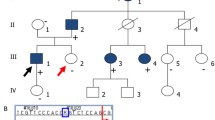Abstract
We report on linkage analysis and haplotype characterization in 12 Cuban families with autosomal dominant polycystic kidney disease (ADPK) using PKD1-linked markers. They included both standard restriction fragment length polymorphisms (26.6., BLu24, and pGGGl) as well as microsatellite polymorphisms (CW2, 16AC2.5, and SM6). All of the examined families were fully informative for genetic diagnosis and no evidence of unlinked families was found. Analysis of two recombination events places PKD1 distal to the marker BLu24 and reduces the size of the region likely to contain the disease gene by approximately 300 kb. The allele frequencies of each marker were similar in the ADPKD and normal populations.
Similar content being viewed by others
References
Bear JC, McManamon P, Morgan J, Payne RH, Lewis H, Gault MH, Churchill DN (1984) Age at clinical onset and at ultrasonographic detection of adult polycystic kidney disease: data for genetic counselling. Am J Med Genet 18:45–53
Bear JC, Parfrey PS, Morgan JM, Martin CJ, Cramer BC (1992) Autosomal dominant polycystic kidney disease: new information for genetic counselling. Am J Med Genet 43:548–553
Breuning MH, Snijdewint FGM, Smits JR, Dauwerse JG, Saris JJ, Ommen GJB Van (1990) A TaqI polymorphism identified by 26–6 (D16S125) proximal to the locus affecting adult polycystic disease (PKD1) on chromosome 16. Nucleic Acids Res 18:3106
Feinberg AP, Vogelstein B (1983) A technique for radiolabeling DNA restriction endonuclease fragments to high specific activity. Anal Biochem 132:6–13
Gabow PA (1992) Polycystic kidney disease: clues to pathogenesis. Kidney Int 40:989–996
Germino GG, Barton NJ, Lamb J, Higgs DR, Harris P, Scherer G, Nakamura Y, Reeders ST (1990) Identification of a locus which shows no genomic recombination with the autosomal dominant polycystic kidney disease gene on chromosome 16. Am J Hum Genet 46:925–933
Germino GG, Weinstat SD, Himmelbauer H, Gillespie GA, Somlo S, Wirth B, Barton N, Harris KL, Frischauf AM, Reeders ST (1992) The gene for autosomal dominant polycystic kidney disease lies in a 750-kb CpG-rich region. Genomics 13:144–151
Harris PC, Breuning MH, Thomas S, Coto E, Radcliffe PJ, López-Larrea C (1991) Rapid genetic analysis of families with polycystic kidney disease 1 by means of a microsatellite marker. Lancet 11:1484–1487
Kimberling WJ, Kumar S, Gabow PA, Kenyon JB, Connoly CJ, Somlo S (1993) Autosomal dominant polycystic kidney disease: localization of the second gene to chromosome 4q13-q23. Genomics 18:467–472
Lathrop GM, Lalouel JM (1984) Easy calculations of lod scores and genetic risks on small computers. Am J Hum Genet 36:460–465
Ott J (1985) Analysis of human linkage. John Hopkins, Baltimore
Parfrey PS, Bear JC, Morgan J, Cramer BC, McManamon PJ, Gault MH, Churchill DN, Singh M, Hewitt R, Somlo S, Reeders ST (1990) The diagnosis and prognosis of autosomal dominant polycystic kidney disease. N Engl J Med 323:1085–1090
Peral B (1993) Estudio genético de poliquistosis renal del adulto en la población española. PhD Thesis, Universidad Autónoma de Madrid
Peral B, San Millán JL, Hernández C, Valero A, Lathrop GM, Beckmann J, Moreno F (1993) Estimating locus heterogeneity in autosomal dominant polycystic kidney disease (ADPKD) in the Spanish population. J Med Genet 30:910–913
Perai B, Ward CJ, San Millán JL, Thomas S, Stallings RL, Moreno F, Harris PC (1994) Evidence of linkage disequilibrium in the Spanish polycystic kidney disease 1 (PKD1) population. Am J Hum Genet 54:899–908
Peters DJM, Sandkuijl LA (1992) Genetic heterogeneity of polycystic kidney disease in Europe. In: Breuning MH, Devoto M, Romeo G (eds) Contributions to nephrology 97: polycystic kidney disease. Krager, Basel, pp 128–139
Peters DJM, Spruit L, Saris JJ, Ravine D, Sandkuijl LA, Fossdal R, Boersma J, Eijk R van, Nørby, Constantinou-Deltas CD, Pierides A, Brissenden JE, Frants RR, Ommen GJB van, Breuning MH (1993) Localization of a second gene for autosomal dominant polycystic kidney disease on chromosome 4. Nature Genet 5:359–362
Pound SE, Carothers AD, Pignatelli PM, Macnicol AM, Watson ML, Wright AF (1992) Evidence for linkage disequilibrium between D16S94 and the adult onset polycystic kidney disease (PKD1) gene. J Med Genet 29:247–248
Ravine D, Walker RG, Gibson RN, Forrest SM, Richards RI, Friend K, Sheffield LJ, Kincaid-Smith P, Danks D (1992) Phenotype and genotype heterogeneity in autosomal dominant polycystic kidney disease. Lancet 340:1330–1333
Reeders ST, Breuning MH, Davies KH, Nicholls RD, Jarman AP, Higgs DR, Pearson PL, Weatherall DJ (1985) A highly polymorphic DNA marker linked to adult polycystic kidney disease on chromosome 16. Nature 317:542–544
Somlo S, Wirth B, Germino GG, Weinstat-Saslow D, Gillespie GAJ, Himmelbauer H, Steevens L, Coucke P, Willems Bachner L, Coto E, López-Larrea C, Peral B, San Millàn JL, Saris JJ, Breuning MH, Frischauf AM, Reeders ST (1992) Fine genetic localization of the gene for autosomal dominant polycystic kidney disease (PKDI) with respect to physically mapped markers. Genomics 13:152–158
The European Polycystic Kidney Disease Consortium (1994) The polycystic kidney disease 1 gene encodes a 14 kb transcript and lies within a duplicated region of chromosome 16. Cell 77:881–894
Thompson AD, Shen Y, Holman K, Sutherland GR, Callen DF, Richards RI (1992) Isolation and characterization of (AC)n microsatellite markers from human chromosome 16. Genomics 13:402–408
Wright AF, Teague PW, Pound SE, Pignatelli PM, Macnicol AM, Carothers AD, Mey RJ De, Allan PL, Watson ML (1993) A study of genetic linkage heterogeneity in 35 adult-onset polyystic kidney disease families. Hum Genet 90:569–571
Author information
Authors and Affiliations
Rights and permissions
About this article
Cite this article
Viribay, M., Ferreira, R., Perai, B. et al. Genetic analysis of Cuban autosomal dominant polycystic kidney disease kindreds using RFLPs and microsatellite polymorphisms linked to the PKD1 locus. Hum Genet 94, 432–436 (1994). https://doi.org/10.1007/BF00201607
Received:
Revised:
Issue Date:
DOI: https://doi.org/10.1007/BF00201607




